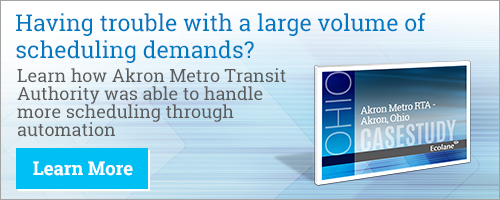Public transit agencies face a myriad of challenges on a daily basis. If you put a group of transit directors and operations managers in the same room to talk about the issues they face, you would find they have a lot in common and can sympathize with one another.
While most agencies face common challenges and pain points, it’s true that these issues can be greatly impacted by the size of the agency.
The larger the transit agency, the more challenges arise that need to be addressed.
Some typical challenges that are prevalent in large transit agencies are complex processes and operations; longer hours, more days of service, multiple depot locations and subcontractors for vehicles and dispatching.
Routing and scheduling software can help large agencies overcome these challenges. Here are the benefits that transit software can bring specifically to large agencies, addressing all of their pain points:
-
Complex Processes & Operations
With a larger transit agency, there are more moving parts operationally. If an agency is bogged down by manual processes, efficiency is not easily attained and visibility is limited. With the right scheduling software, manual processes can be minimized. Change orders, re-routing, dispatching and reporting can all be automated thanks to real-time capabilities. This leaves less room for human error and more time for critical personnel to focus their efforts on other important areas of operations.
Managers can often pinpoint issues and bottlenecks, allowing them to correct the operational deficiencies and improve agency operations altogether. This often leads to a reduction in overtime hours for staff and allows operations to run more optimally as a whole. Greater visibility can be achieved for driver performance, no-shows, and other critical transit metrics.
-
Longer Hours & More Days of Service
A large transit agency typically operates for longer hours and more consecutive days than smaller agencies. Because of this, the number of trips that are being made in a given day grow exponentially, as do the number of riders that are being served. When a large number of passengers are being served, there is a lot of room for error and it’s easier to let excellent customer service fall by the wayside. With transit scheduling software, customer service often improves for large agencies because riders are given more visibility into route information, ETA for their pick-up, and can easily reschedule or cancel a ride without jumping through a lot of hoops. The software will automatically update the driver’s itinerary and will prompt them to take the most optimal route for their next pickup. In turn, this will improve an agency’s on-time performance (which is a critical metric in gauging customer satisfaction) and will increase rides per hour.
-
Multiple Depot Locations & Agencies
As mentioned previously, mid to large size agencies typically have a lot of moving parts when it comes to agency operations. If an agency has multiple depot locations for vehicles and multiple subcontractors dispatching rides, things can get complicated. Agencies using manual processes can have instances where multiple drivers from different subcontractors are on the same road to pick up one passenger, which is an obvious efficiency issue.
The right scheduling software using a brokerage model can search first availability from the “least cost provider” so the best rate will automatically be booked. Schedulers can book trips directly to a vehicle as opposed to sending to a provider. This allows for more efficient grouping of trips by geography, time, or common destination. Subcontractor portals can be built for added visibility and ease of use.
While large transit agencies may experience some unique challenges, the right routing and scheduling software can help address these challenges and will bring new benefits to agency operations. These benefits will create efficiencies, better cost savings, improved customer service, and greater visibility for strategic decision-making.
About the Author

Ecolane
Read Ecolane's blog articles for perspective, opinion and information on transit and paratransit issues.
%20(200%20x%20100%20px).png)

